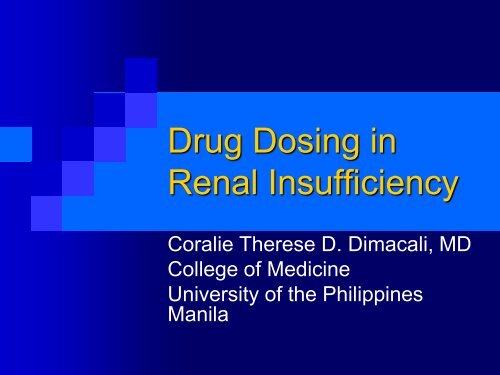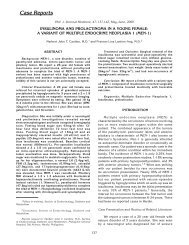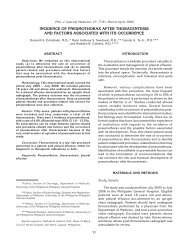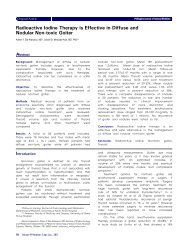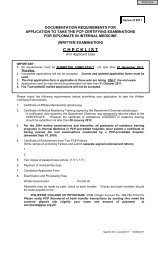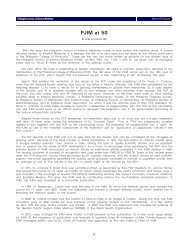Drug Dosing in Renal Insufficiency - Philippine College of Physicians
Drug Dosing in Renal Insufficiency - Philippine College of Physicians
Drug Dosing in Renal Insufficiency - Philippine College of Physicians
Create successful ePaper yourself
Turn your PDF publications into a flip-book with our unique Google optimized e-Paper software.
<strong>Drug</strong> <strong>Dos<strong>in</strong>g</strong> <strong>in</strong><br />
<strong>Renal</strong> <strong>Insufficiency</strong><br />
Coralie Therese D. Dimacali, MD<br />
<strong>College</strong> <strong>of</strong> Medic<strong>in</strong>e<br />
University <strong>of</strong> the Philipp<strong>in</strong>es<br />
Manila
Declaration <strong>of</strong> Conflict <strong>of</strong> Interest<br />
•For today’s lecture on <strong>Drug</strong><br />
<strong>Dos<strong>in</strong>g</strong> <strong>in</strong> <strong>Renal</strong> <strong>Insufficiency</strong>, I<br />
declare that I have no potential<br />
conflict <strong>of</strong> <strong>in</strong>terest.
Objectives<br />
• Discuss the effects <strong>of</strong> impaired kidney<br />
function on drug pharmacok<strong>in</strong>etics<br />
• Describe the pr<strong>in</strong>ciples <strong>of</strong><br />
pharmacotherapy <strong>in</strong> patients with renal<br />
disease<br />
• Calculate drug dosages for patients with<br />
renal <strong>in</strong>sufficiency
Oral<br />
absorption<br />
Parenteral drug<br />
adm<strong>in</strong>istration<br />
Bioavailability<br />
Liver<br />
First-pass effect<br />
Systemic<br />
Circulation<br />
Prote<strong>in</strong>-bound<br />
Free<br />
Elim<strong>in</strong>ation<br />
Kidneys<br />
Parent drug<br />
Active / Inactive<br />
metabolites<br />
Tissue receptor<br />
action
<strong>Drug</strong> Pharmacok<strong>in</strong>etics<br />
• Bioavailability<br />
% <strong>of</strong> a drug dose that appears <strong>in</strong> the central<br />
circulation after oral adm<strong>in</strong>istration compared<br />
to the IV route<br />
• <strong>Drug</strong> distribution<br />
• <strong>Drug</strong> metabolism<br />
• <strong>Renal</strong> handl<strong>in</strong>g
Bioavailability <strong>in</strong> <strong>Renal</strong> <strong>Insufficiency</strong><br />
• Decreased drug absorption<br />
Nausea and vomit<strong>in</strong>g<br />
Alkal<strong>in</strong>iz<strong>in</strong>g effect <strong>of</strong> salivary urea<br />
Use <strong>of</strong> PPIs and H 2 -receptor blockers<br />
Use <strong>of</strong> phosphate b<strong>in</strong>ders<br />
Gut edema<br />
Bacterial colonization<br />
Altered <strong>in</strong>test<strong>in</strong>al motility<br />
• Altered hepatic first-pass metabolism
Bioavailability <strong>in</strong> CKD<br />
• <strong>Drug</strong> absorption<br />
Absolute bioavailability rarely altered<br />
There • Reduced: is no quantitative furosemide, p<strong>in</strong>dolol strategy to predict<br />
changes • Increased: for one Beta drug blockers, based dihydrocode<strong>in</strong>e, on data from<br />
dextropropoxyphene<br />
another <strong>in</strong> the same class<br />
Alterations <strong>in</strong> peak concentration (C max ) and<br />
time at which peak concentration is atta<strong>in</strong>ed<br />
(T max )
<strong>Drug</strong> Pharmacok<strong>in</strong>etics<br />
• Bioavailability<br />
• <strong>Drug</strong> Distribution<br />
Volume <strong>of</strong> distribution (V d )<br />
• ratio <strong>of</strong> adm<strong>in</strong>istered dose to the result<strong>in</strong>g plasma<br />
concentration <strong>in</strong> equilibrium<br />
V d =<br />
Dose<br />
Blood concentration<br />
• Useful for predict<strong>in</strong>g load<strong>in</strong>g doses<br />
Plasma prote<strong>in</strong> b<strong>in</strong>d<strong>in</strong>g
Volume <strong>of</strong> distribution (V d ) <strong>in</strong> CKD<br />
• Increased V d<br />
Edema and ascites<br />
Hypoalbum<strong>in</strong>emia<br />
Potentially decrease<br />
plasma drug levels <strong>of</strong><br />
water-soluble and<br />
prote<strong>in</strong>-bound drugs<br />
• Decreased V d<br />
Muscle wast<strong>in</strong>g<br />
Volume depletion<br />
Potentially <strong>in</strong>crease<br />
plasma drug levels <strong>of</strong><br />
water-soluble drugs
Plasma prote<strong>in</strong> b<strong>in</strong>d<strong>in</strong>g <strong>in</strong> CKD<br />
• Acidic drugs have reduced plasma prote<strong>in</strong><br />
b<strong>in</strong>d<strong>in</strong>g due to decreased album<strong>in</strong><br />
concentration and album<strong>in</strong> aff<strong>in</strong>ity<br />
Unbound fractions may <strong>in</strong>crease<br />
• Increased drug toxicity<br />
• Increased drug metabolism<br />
Lower drug plasma concentrations<br />
• Altered prote<strong>in</strong> b<strong>in</strong>d<strong>in</strong>g may decrease T 1/2
<strong>Drug</strong> Pharmacok<strong>in</strong>etics<br />
• Bioavailability<br />
• <strong>Drug</strong> distribution<br />
• <strong>Drug</strong> metabolism
<strong>Drug</strong> metabolism <strong>in</strong> CKD<br />
• Slow<strong>in</strong>g down <strong>of</strong> reduction and hydrolysis<br />
reactions<br />
• Normal rates <strong>of</strong> glucuronidation, sulfation,<br />
S<strong>in</strong>ce there is significant patient variation, no<br />
conjugation and microsomal oxidation reactions<br />
prior assumptions will substitute for careful<br />
• Consider adverse effects <strong>of</strong> pharmacologically<br />
cl<strong>in</strong>ical evaluation.<br />
active metabolites<br />
Seizures from meperid<strong>in</strong>e<br />
Peripheral neuropathy from nitr<strong>of</strong>uranto<strong>in</strong><br />
Respiratory depression from morph<strong>in</strong>e
<strong>Drug</strong> Pharmacok<strong>in</strong>etics<br />
• Bioavailability<br />
• <strong>Drug</strong> distribution<br />
• <strong>Drug</strong> metabolism<br />
• <strong>Renal</strong> handl<strong>in</strong>g <strong>of</strong> drugs
<strong>Renal</strong> handl<strong>in</strong>g <strong>of</strong> drugs<br />
• <strong>Renal</strong> excretion dependent on:<br />
Glomerular filtration rate (GFR)<br />
• Molecular size<br />
• Prote<strong>in</strong> b<strong>in</strong>d<strong>in</strong>g<br />
Tubular secretion<br />
• May compensate for decreased prote<strong>in</strong> b<strong>in</strong>d<strong>in</strong>g<br />
Tubular reabsoprtion<br />
• As rate <strong>of</strong> creat<strong>in</strong><strong>in</strong>e clearance (Cl Cr ) decreases, drugs<br />
dependent on tubular secretion are also excreted more<br />
slowly.<br />
• The Cl Cr is a reasonable estimate <strong>of</strong> GFR and the tubular<br />
capacity for drug excretion.
<strong>Renal</strong> handl<strong>in</strong>g <strong>of</strong> drugs <strong>in</strong> CKD<br />
• Decreased drug clearance<br />
• Prolonged plasma half-life <strong>of</strong> drugs<br />
• Accumulation <strong>of</strong> ‘active’ drug metabolites<br />
• Decreases <strong>in</strong> renal drug metabolism<br />
• Changes <strong>in</strong> drug distribution: prote<strong>in</strong><br />
b<strong>in</strong>d<strong>in</strong>g
<strong>Drug</strong> metabolism and drug<br />
handl<strong>in</strong>g <strong>in</strong> AKI<br />
• Changes <strong>in</strong> metabolism<br />
There are large gaps <strong>in</strong> knowledge <strong>of</strong><br />
Delayed drug metabolism<br />
drug Variable metabolism effect on hepatic and metabolic disposition activity <strong>in</strong><br />
patients with multiorgan dysfunction<br />
• Reduced drug clearance<br />
syndrome, multisystem organ failure<br />
Hypoxia<br />
and Decreased AKI; thus, prote<strong>in</strong> synthesis patients are at risk <strong>of</strong><br />
underdos<strong>in</strong>g and overdos<strong>in</strong>g.<br />
Competitive <strong>in</strong>hibition from medications<br />
Decreased hepatic perfusion
Mathematics <strong>of</strong> drug elim<strong>in</strong>ation<br />
• Total body drug clearance = <strong>Drug</strong> dose<br />
AUC<br />
• <strong>Renal</strong> clearance = Total amount <strong>of</strong> drug <strong>in</strong> ur<strong>in</strong>e<br />
Plasma drug concentration<br />
• <strong>Renal</strong> clearance rate =<br />
Clearance<br />
Sample collection time<br />
• T 1/2 = V d x 0.693<br />
<strong>Drug</strong> clearance
Application <strong>of</strong> Pharmacok<strong>in</strong>etic Parameters<br />
Parameter<br />
Bioavailability (F)<br />
Volume <strong>of</strong> distribution (V d )<br />
Clearance (C)<br />
Half-life (T 1/2 )<br />
Cl<strong>in</strong>ical Application<br />
Determ<strong>in</strong>es amount <strong>of</strong> drug<br />
reach<strong>in</strong>g systemic circulation and<br />
amount at site <strong>of</strong> action<br />
Determ<strong>in</strong>es size <strong>of</strong> a load<strong>in</strong>g dose<br />
Determ<strong>in</strong>es ma<strong>in</strong>tenance dose<br />
Determ<strong>in</strong>es amount <strong>of</strong> time<br />
needed to reach steady-state<br />
serum concentrations
Approach to adjust drug dosage<br />
1. Obta<strong>in</strong> history and relevant cl<strong>in</strong>ical<br />
<strong>in</strong>formation.<br />
2. Estimate GFR.<br />
3. Review current medications.<br />
4. Calculate <strong>in</strong>dividualized treatment<br />
regimen.<br />
5. Monitor.<br />
6. Revise regimen.<br />
KDIGO 2011
Assessment <strong>of</strong> kidney function<br />
• GFR should be standard measure to<br />
evaluate kidney function for drug dos<strong>in</strong>g<br />
purposes<br />
• Cl<strong>in</strong>icians should use the most accurate<br />
method/tool to assess kidney function<br />
for the <strong>in</strong>dividual patient<br />
KDIGO 2011
Estimation <strong>of</strong> GFR and Creat<strong>in</strong><strong>in</strong>e<br />
Clearance<br />
• Cockcr<strong>of</strong>t and Gault<br />
Cl Cr =<br />
(140 – age) x Wt (kg)<br />
S Cr (mg/dl) x 72<br />
x 0.85 (F)<br />
• MDRD Study Equation<br />
GFR = 175.6 x SCr -1.154 x Age -0.203 x 1.212<br />
[black] x 0.742 [female]
Estimation <strong>of</strong> GFR and Creat<strong>in</strong><strong>in</strong>e<br />
Clearance<br />
• CKD-EPI formula<br />
GFR = 141 x m<strong>in</strong>(SCr/κ,1) α x max(SCr/<br />
κ,1) -1.209 x 0.993 Age x 1.159<br />
[black] x 1.018 [female]<br />
κ = 0.7 [females], 0.9 [males]<br />
α = -0.329 [females], -0.411 [males]<br />
M<strong>in</strong> = m<strong>in</strong>imum <strong>of</strong> SCr/κ or 1<br />
Max = maximum <strong>of</strong> SCr/ κ or 1<br />
Age = measured <strong>in</strong> years
Estimation <strong>of</strong> GFR <strong>in</strong> AKI<br />
• No estimat<strong>in</strong>g equations can provide an<br />
accurate estimate <strong>of</strong> GFR <strong>in</strong> AKI<br />
• Timed clearances <strong>of</strong> creat<strong>in</strong><strong>in</strong>e and urea<br />
may be particularly <strong>of</strong> value for AKI<br />
• Measure creat<strong>in</strong><strong>in</strong>e clearance with<br />
<strong>in</strong>corporation <strong>of</strong> mean <strong>of</strong> the beg<strong>in</strong>n<strong>in</strong>g<br />
and end<strong>in</strong>g serum creat<strong>in</strong><strong>in</strong>e value as an<br />
estimate <strong>of</strong> GFR<br />
KDIGO 2011
Goals <strong>of</strong> therapy<br />
• Ma<strong>in</strong>ta<strong>in</strong> efficacy while avoid<strong>in</strong>g drug<br />
accumulation and associated adverse<br />
reactions.<br />
Ma<strong>in</strong>ta<strong>in</strong> peak, trough or average<br />
steady-state drug concentration<br />
Optimize time above the MIC or ratio <strong>of</strong><br />
AUC to MIC
Prescrib<strong>in</strong>g for a patient with renal dysfunction<br />
Ascerta<strong>in</strong> level <strong>of</strong> renal function (% normal Cl Cr )<br />
Establish <strong>in</strong>tegrity <strong>of</strong> liver metabolism<br />
Establish load<strong>in</strong>g dose<br />
Ma<strong>in</strong>tenance dose: dose reduction vs <strong>in</strong>terval extension<br />
Check for drug <strong>in</strong>teractions<br />
Decide on blood level monitor<strong>in</strong>g
Calculat<strong>in</strong>g <strong>in</strong>dividualized regimen<br />
• Load<strong>in</strong>g dose (LD) required if:<br />
drug has a long half-life<br />
there is need to rapidly achieve desired<br />
steady-state concentration<br />
volume <strong>of</strong> distribution (VD) is significantly<br />
<strong>in</strong>creased<br />
LD P t = Usual LD x<br />
Vd Pt<br />
Normal Vd
Calculat<strong>in</strong>g <strong>in</strong>dividualized regimen<br />
• Generally no change <strong>in</strong> LD EXCEPT for digox<strong>in</strong><br />
(50-75% <strong>of</strong> usual LD due to reduced Vd <strong>in</strong> renal<br />
failure)<br />
• With volume contraction, lower standard LD <strong>of</strong><br />
am<strong>in</strong>oglycosides by 20-25% to avoid toxicity<br />
• In AKI, <strong>in</strong>creased Vd <strong>of</strong> many drugs, especially<br />
hydrophilic antibiotics (Beta lactams,<br />
cephalospor<strong>in</strong>s, penems) necessitates<br />
adm<strong>in</strong>istration <strong>of</strong> aggressive load<strong>in</strong>g doses (25-<br />
50% greater)
Calculat<strong>in</strong>g <strong>in</strong>dividualized regimen<br />
• Ma<strong>in</strong>tenance dose<br />
Prolong<strong>in</strong>g dose <strong>in</strong>terval and ma<strong>in</strong>ta<strong>in</strong><strong>in</strong>g<br />
same dose results <strong>in</strong> achievement <strong>of</strong> similar<br />
peak and trough concentrations and AUC<br />
Adjust to patient’s renal function, as reflected<br />
by the drug’s T 1/2<br />
Initiate at normal or near-normal dosage<br />
regiments consider<strong>in</strong>g the positive fluid<br />
balance <strong>in</strong> early AKI
Calculat<strong>in</strong>g <strong>in</strong>dividualized regimen<br />
• Ma<strong>in</strong>tenance dose<br />
Chang<strong>in</strong>g dos<strong>in</strong>g <strong>in</strong>terval<br />
Normal Cl Cr<br />
<strong>Dos<strong>in</strong>g</strong> <strong>in</strong>terval =<br />
x Normal <strong>in</strong>terval<br />
Patient’s Cl Cr<br />
Reduc<strong>in</strong>g dose given at standard <strong>in</strong>tervals<br />
Dose =<br />
Patient’s Cl Cr<br />
Normal Cl Cr<br />
x Normal dose
Calculat<strong>in</strong>g <strong>in</strong>dividualized regimen<br />
• Ma<strong>in</strong>tenance dose<br />
Chang<strong>in</strong>g dos<strong>in</strong>g <strong>in</strong>terval<br />
100<br />
<strong>Dos<strong>in</strong>g</strong> <strong>in</strong>terval =<br />
x 8 hours = 40 hrs.<br />
20<br />
Reduc<strong>in</strong>g dose given at standard <strong>in</strong>tervals<br />
20<br />
Dose =<br />
x 1000 mg = 200 mg<br />
100
ke = 0.693 / T 1/2<br />
Dtsch Arztebl Int 2010; 107(37): 647–56
Calculat<strong>in</strong>g <strong>in</strong>dividualized regimen<br />
• Dettli’s proportionality rules:<br />
Rule 1: Dose <strong>of</strong> a drug must be reduced <strong>in</strong><br />
<strong>in</strong>verse proportion to the T1/2<br />
Rule 2: The <strong>in</strong>terval (Tau) between doses<br />
must be prolonged proportionally to the T1/2<br />
D D norm<br />
.<br />
T1/2 norm<br />
=<br />
Tau Tau norm T1/2
Calculat<strong>in</strong>g <strong>in</strong>dividualized regimen<br />
• Dettli’s proportionality rules:<br />
If dos<strong>in</strong>g <strong>in</strong>terval unchanged, AUC same but<br />
with higher trough values—may prompt<br />
physician to wrongly lower the dose<br />
Implies absurdly low doses or wide <strong>in</strong>tervals<br />
between doses
Calculat<strong>in</strong>g <strong>in</strong>dividualized regimen<br />
• Halv<strong>in</strong>g rule <strong>of</strong> Kun<strong>in</strong>:<br />
Start<strong>in</strong>g dose should be the same as the<br />
normal dose, and thereafter half the start<strong>in</strong>g<br />
dose should be given at <strong>in</strong>tervals equal to one<br />
half-life.<br />
If the half-life is shorter than the dos<strong>in</strong>g<br />
<strong>in</strong>terval, dose adjustment is usually<br />
unnecessary.<br />
Achieves effective peak levels but markedly<br />
higher trough levels more adverse effects.
Dtsch Arztebl Int 2010; 107(37): 647–56
Calculat<strong>in</strong>g <strong>in</strong>dividualized regimen<br />
“Start low, go slow”<br />
vs.<br />
“Go fast, start high”
<strong>Drug</strong> dos<strong>in</strong>g considerations for CKD<br />
• <strong>Drug</strong> dos<strong>in</strong>g recommendations may be different<br />
from orig<strong>in</strong>al pharmacok<strong>in</strong>etic study due to<br />
variability <strong>in</strong> serum creat<strong>in</strong><strong>in</strong>e determ<strong>in</strong>ations<br />
• Use the most appropriate tool to assess kidney<br />
function<br />
• <strong>Drug</strong> dosages should be adjusted accord<strong>in</strong>g to<br />
FDA or EMA approved product label<strong>in</strong>g<br />
KDIGO 2011
<strong>Drug</strong> dos<strong>in</strong>g considerations for CKD<br />
• Peer-reviewed literature recommendations<br />
should be used to guide drug-dosage<br />
adjustments<br />
• Obese CKD patients with large variations<br />
<strong>in</strong> prote<strong>in</strong> levels should have drug dosage<br />
<strong>in</strong>dividualized based on best available<br />
evidence.<br />
KDIGO 2011
<strong>Drug</strong> level monitor<strong>in</strong>g<br />
• Ensures therapeutic levels while avoid<strong>in</strong>g toxicity<br />
• Measurement <strong>of</strong> serum drug concentrations<br />
should be done especially for drugs with a<br />
narrow therapeutic range<br />
• <strong>Drug</strong> assays only measure total blood<br />
concentrations and may underestimate plasma<br />
levels or the active or free form <strong>of</strong> the drug<br />
• If not possible, dosage adjustments should be<br />
done <strong>in</strong> the presence <strong>of</strong> excessive<br />
pharmacologic effects or toxicity
<strong>Drug</strong> dos<strong>in</strong>g considerations for HD<br />
• Dose should be given post-HD. Consider<br />
supplementary dose <strong>in</strong> addition to the dose<br />
adjusted to kidney failure after HD.<br />
• Supplementary dose derived from studies <strong>of</strong><br />
low-flux membranes should be empirically<br />
<strong>in</strong>creased by 50% when us<strong>in</strong>g hi-flux dialyzers.<br />
• Extended dialysis regimens with high diffusive<br />
membranes <strong>in</strong>crease drug clearance and<br />
supplementary dose may need to be <strong>in</strong>creased.<br />
KDIGO 2011
<strong>Drug</strong> dos<strong>in</strong>g considerations for PD<br />
• Perform antibiotic load<strong>in</strong>g by an extended cycle<br />
<strong>in</strong> CAPD and APD<br />
• Transperitoneal<br />
For most drugs<br />
drug<br />
<strong>in</strong> cl<strong>in</strong>ical<br />
movement<br />
use,<br />
may<br />
there<br />
be<br />
is<br />
less<br />
little<br />
effective <strong>in</strong> the acute phase <strong>of</strong> peritoneal<br />
evidence <strong>in</strong>fection when <strong>of</strong> significant <strong>in</strong>flammation-related drug removal capillary dur<strong>in</strong>g<br />
hyperperfusion subsides chronic PD.<br />
• Short dwell times <strong>in</strong> APD may prevent<br />
accumulation <strong>of</strong> antibiotic <strong>in</strong> the peritoneal<br />
cavity.<br />
• Monitor<strong>in</strong>g <strong>of</strong> drug blood levels is advocated.<br />
KDIGO 2011
Key po<strong>in</strong>ts<br />
• <strong>Renal</strong> dysfunction may result <strong>in</strong> altered<br />
pharmacok<strong>in</strong>etics and pharmacodynamics <strong>of</strong><br />
<strong>in</strong>dividual drugs.<br />
• The goal <strong>of</strong> therapy is to ma<strong>in</strong>ta<strong>in</strong> efficacy while<br />
avoid<strong>in</strong>g drug accumulation and associated<br />
adverse effects.<br />
• An <strong>in</strong>dividualized approach is recommended,<br />
tak<strong>in</strong>g <strong>in</strong>to consideration the <strong>in</strong>tegrity <strong>of</strong> other<br />
organ systems and potential drug <strong>in</strong>teractions.
Key po<strong>in</strong>ts<br />
• Monitor<strong>in</strong>g drug levels may be necessary<br />
to ensure therapeutic levels while avoid<strong>in</strong>g<br />
toxicity.<br />
• <strong>Physicians</strong> should be vigilant <strong>in</strong><br />
recogniz<strong>in</strong>g adverse events.<br />
• In the <strong>in</strong>tensive care unit, a “Go fast, start<br />
high” policy avoids subtherapeutic blood<br />
levels.
Key po<strong>in</strong>ts<br />
• Consider giv<strong>in</strong>g scheduled doses after HD<br />
sessions OR give supplemental doses<br />
immediately post HD<br />
• For most drugs <strong>in</strong> cl<strong>in</strong>ical use, there is little<br />
evidence <strong>of</strong> significant drug removal<br />
dur<strong>in</strong>g chronic PD.
References<br />
Am Fam Physician 2007; 75:1487-96


